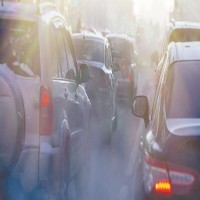Health experts paint a gloomy picture of air pollution

By Shaurya Khatri
Kathmandu, Dec. 29: The stomach-churning anti-smoking adverts that highlight cigarettes as the number-one cause of lung cancer are only partially true. In the current climate marked by increasing air pollution especially in sprawling urban centres like Kathmandu, even breathing has become a health hazard.
“Breathing Kills!,” cautions Dr. Arvind Kumar, Founder of Lung Care Foundation, who in his 30-year-career as a lung cancer surgeon, has firsthand witnessed the mayhem inflicted by the toxic pollutants.
Speaking at the virtual ‘Science-policy dialogue on health impacts of air pollution’ organised by the Ministry of Health and Population (MoHP), Department of Environment (DoEnv), WHO, and Clean Energy Nepal (CEN), Dr. Kumar made some shocking revelations.
According to his observations, back in 1988, 90 per cent lung cancer patients were smokers. In 2018, the statistic changed considerably, with non-smokers being as susceptible to cancer as any smoker. “Among those suffering from lung cancer today, 50 per cent are non-smokers,” exclaimed Dr. Kumar.
Based in New Delhi, the Chest-Specialist has closely observed the lungs of numerous patients and is severely distraught by what he has seen. “Twenty years ago, I used to see healthy pink lungs. But today, all I see is diseased black lungs that have become a repository of toxins,” informed Dr. Kumar, stressing on the deteriorating health of an average commoner living in Cities like New Delhi.
The case of Kathmandu is no less different from its neighbour. The statistic by State of Global Air 2020, reports 42,100 deaths annually as a result of air pollution, which as Dr. Sanjay Nath Khanal, Professor at the Department of Environmental Science and Engineering, Kathmandu University, pointed out an average of 115 deaths per day owing to the toxic air.
“The PM2.5 level in the air of Kathmandu is five times more than WHO standards,” said Khanal.
Among the four significant contributors to air pollution, vehicular emission and road dust are the major polluters in Kathmandu followed by household burning of firewood, solid waste, and brick industry.
A research jointly carried out by Kathmandu University and WHO’s Urban Health Initiative (UHI), claims that the toxic air has resulted in an upsurge of non-communicable diseases, particularly impacting the lungs. “Almost 66 per cent of deaths from Chronic Obstructive Pulmonary Disease (COPD), 34 per cent from lung cancer and ischemic heart disease are attributable to air pollution,” stated Khanal.
Polluted air also damages every organ in our body, and even the unborn fetus. Almost 67 per cent of households burn traditional firewood for fuel, which has resulted in about 22 per cent of neo-natal deaths, informed Dr. Sangeeta K. Mishra, Director, Maternity and Women’s Hospital. “Carbon monoxide can cross the placenta and get into the baby’s blood,” explained Dr. Mishra.
More than an environmental concern, rising pollution is an alarming public health issue.
“Bearing this in mind, the government has come up with a handful of policy interventions to curtail the pollution impacts on health such as the National Health Policy 2014, the National Health Sector Strategy 2015, and the Kathmandu Valley Air Quality Management Action Plan, KVAQMAP-2020,” said Dr. Jageshwar Gautam, Spokesperson at MoHP.
However, as Dr. Roshan Pokharel, Chief Specialist at the Ministry, admitted none have been well-implemented. Only if the plans laid out in the KVAQMAP-2020, which promotes using cleaner household cooking energy, electric vehicles, cycling lanes, upgraded brick kiln technology, biogas, Bus Rapid Transit (BRT), among others, PM2.5 concentration will go down by 40 to 83 per cent by 2030, as per the KU/UHI research.
But policies can only drive the cause so far, when, as Dr. Arvind Kumar claimed, the public is so abysmally ill-informed. Realising the lack of awareness, Dr. Kumar has initiated the Doctor for Clean Air campaign to advocate for a pollution-free environment and practices, because “doctors are the authority on this matter and if they speak out, masses will listen.”
He has also encouraged doctors from Nepal to take part in the campaign, and eminent health professionals like Dr. Bhagawan Koirala and Dr. Arjun Karki have expressed their intent towards making the public aware of the damage inflicted by air pollution.
Recent News

Do not make expressions casting dout on election: EC
14 Apr, 2022
CM Bhatta says may New Year 2079 BS inspire positive thinking
14 Apr, 2022
Three new cases, 44 recoveries in 24 hours
14 Apr, 2022
689 climbers of 84 teams so far acquire permits for climbing various peaks this spring season
14 Apr, 2022
How the rising cost of living crisis is impacting Nepal
14 Apr, 2022
US military confirms an interstellar meteor collided with Earth
14 Apr, 2022
Valneva Covid vaccine approved for use in UK
14 Apr, 2022
Chair Prachanda highlights need of unity among Maoist, Communist forces
14 Apr, 2022
Ranbir Kapoor and Alia Bhatt: Bollywood toasts star couple on wedding
14 Apr, 2022
President Bhandari confers decorations (Photo Feature)
14 Apr, 2022











